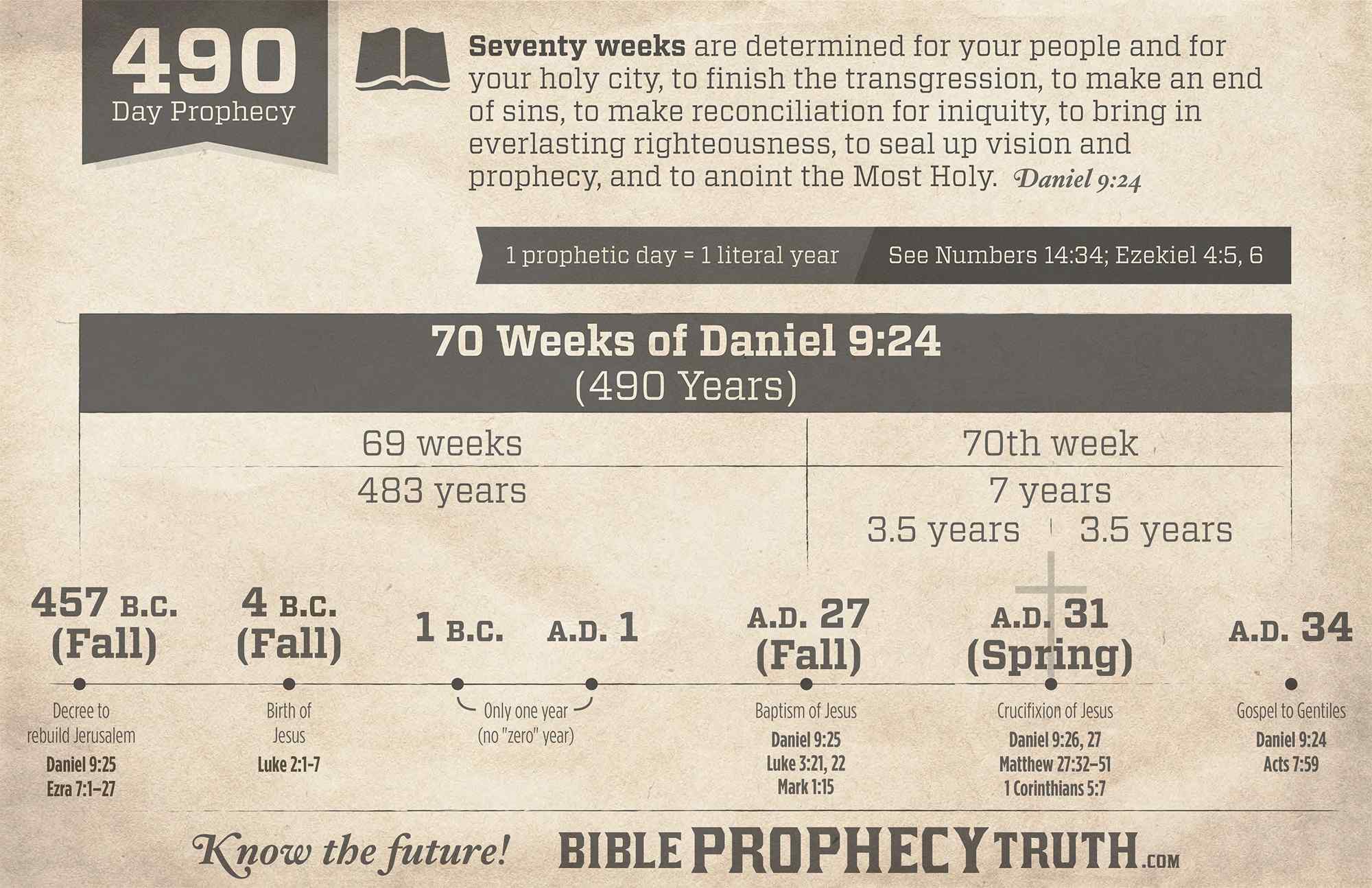
Seventy weeks are determined upon thy people and upon thy holy city, to finish the transgression, and to make an end of sins, and to make reconciliation for iniquity, and to bring in everlasting righteousness, and to seal up the vision and prophecy, and to anoint the most Holy. Know therefore and understand, that from the going forth of the commandment to restore and to build Jerusalem unto the Messiah the Prince shall be seven weeks, and threescore and two weeks: the street shall be built again, and the wall, even in troublous times. And after threescore and two weeks shall Messiah be cut off, but not for himself: and the people of the prince that shall come shall destroy the city and the sanctuary; and the end thereof shall be with a flood, and unto the end of the war desolations are determined. And he shall confirm the covenant with many for one week: and in the midst of the week he shall cause the sacrifice and the oblation to cease, and for the overspreading of abominations he shall make it desolate, even until the consummation, and that determined shall be poured upon the desolate.
The time of the first advent and of some of the chief events clustering about the Saviour’s lifework was made known by the angel Gabriel to Daniel. “Seventy weeks,” said the angel, “are determined upon thy people and upon thy holy city, to finish the transgression, and to make an end of sins, and to make reconciliation for iniquity, and to bring in everlasting righteousness, and to seal up the vision and prophecy, and to anoint the most holy.” Daniel 9:24. A day in prophecy stands for a year. See Numbers 14:34; Ezekiel 4:6. The seventy weeks, or four hundred and ninety days, represent four hundred and ninety years.
A starting point for this period is given: “Know therefore and understand, that from the going forth of the commandment to restore and to build Jerusalem unto the Messiah the Prince shall be seven weeks, and threescore and two weeks” (Daniel 9:25), sixty-nine weeks, or four hundred and eighty-three years. The commandment to restore and build Jerusalem, as completed by the decree of Artaxerxes Longimanus, went into effect in the autumn of 457 B.C. See Ezra 6:14; 7:1, 9. From this time four hundred and eighty-three years extend to the autumn of A.D. 27. According to the prophecy, this period was to reach to the Messiah, the Anointed One. In A.D. 27, Jesus at His baptism received the anointing of the Holy Spirit and soon afterward began His ministry. Then the message was proclaimed, “The time is fulfilled.” Mark 1:15.Then, said the angel, “He shall confirm the covenant with many for one week [seven years].” For seven years after the Saviour entered on His ministry, the gospel was to be preached especially to the Jews; for three and a half years by Christ Himself, and afterward by the apostles. “In the midst of the week He shall cause the sacrifice and the oblation to cease.” Daniel 9:27. In the spring of A.D. 31, Christ, the true Sacrifice, was offered on Calvary. Then the veil of the temple was rent in twain, showing that the sacredness and significance of the sacrificial service had departed. The time had come for the earthly sacrifice and oblation to cease. The 70-week prophecy chartThe one week—seven years—ended in A.D. 34. Then by the stoning of Stephen the Jews finally sealed their rejection of the gospel; the disciples who were scattered abroad by persecution “went everywhere preaching the word” (Acts 8:4); and shortly after, Saul the persecutor was converted and became Paul the apostle to the Gentiles.The many prophecies concerning the Saviour’s advent led the Hebrews to live in an attitude of constant expectancy. Many died in the faith, not having received the promises. But having seen them afar off, they believed and confessed that they were strangers and pilgrims on the earth. From the days of Enoch the promises repeated through patriarchs and prophets had kept alive the hope of His appearing.Not at first had God revealed the exact time of the first advent; and even when the prophecy of Daniel made this known, not all rightly interpreted the message.Century after century passed away; finally the voices of the prophets ceased. The hand of the oppressor was heavy upon Israel. As the Jews departed from God, faith grew dim, and hope well-nigh ceased to illuminate the future. The words of the prophets were uncomprehended by many; and those whose faith should have continued strong were ready to exclaim, “The days are prolonged, and every vision faileth.” Ezekiel 12:22. But in heaven’s council the hour for the coming of Christ had been determined; and “when the fullness of the time was come, God sent forth His Son, ... to redeem them that were under the law, that we might receive the adoption of sons.” Galatians 4:4, 5.Prophets and Kings, pgs. 698-700, EGW
The 70-week prophecy chartThe one week—seven years—ended in A.D. 34. Then by the stoning of Stephen the Jews finally sealed their rejection of the gospel; the disciples who were scattered abroad by persecution “went everywhere preaching the word” (Acts 8:4); and shortly after, Saul the persecutor was converted and became Paul the apostle to the Gentiles.The many prophecies concerning the Saviour’s advent led the Hebrews to live in an attitude of constant expectancy. Many died in the faith, not having received the promises. But having seen them afar off, they believed and confessed that they were strangers and pilgrims on the earth. From the days of Enoch the promises repeated through patriarchs and prophets had kept alive the hope of His appearing.Not at first had God revealed the exact time of the first advent; and even when the prophecy of Daniel made this known, not all rightly interpreted the message.Century after century passed away; finally the voices of the prophets ceased. The hand of the oppressor was heavy upon Israel. As the Jews departed from God, faith grew dim, and hope well-nigh ceased to illuminate the future. The words of the prophets were uncomprehended by many; and those whose faith should have continued strong were ready to exclaim, “The days are prolonged, and every vision faileth.” Ezekiel 12:22. But in heaven’s council the hour for the coming of Christ had been determined; and “when the fullness of the time was come, God sent forth His Son, ... to redeem them that were under the law, that we might receive the adoption of sons.” Galatians 4:4, 5.Prophets and Kings, pgs. 698-700, EGW